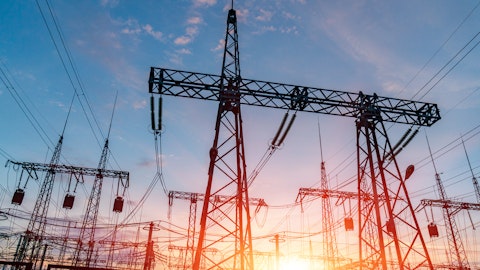Durgesh Chopra: Got it. So back half of the year. And then my next question is on the nuclear fuel. I see sort of you kind of reiterated your nuclear fuel expense projections for 2023. Some of your peers are showing a pretty sizable ramp-up in nuclear fuel costs looking out in the future. Can you comment on that, please?
Jim Burke: Sure. Yes, it’s a good question. It’s one that we’re staying close to. We forward buy nuclear fuel, as you would expect. We buy the various components that allow us to have the fuel assemblies for our reloads. On a historical basis, we’ve seen it be somewhere around $5 a megawatt hour a fairly good estimate, if you were to take all of the capital costs and kind of spread them out over the megawatt hours of production. The team has been forward buying, and that’s why you saw a bigger CapEx number in €˜22. We have a bigger CapEx number in €˜23. Our best view of this is, as you spread that out over the time period in the 2025, 2026, that fuel cost is working its way up from $5 to just sub $6. So if you put that on a on Comanche Peak size unit, $1 is about a $20 million per year impact.
So it’s not jumping to $6, just kind of migrating from a $5 cost on average historically to hedge. It’s looking like it’s going to be sub-$6, but heading towards $6 around that 2026 time frame. And so that gives you a sense that it is definitely on the upward trend, where there’ll be some domestic opportunities for supply down the road. That remains to be seen, but I think the team has done a very nice job of getting ahead of the nuclear fuel cost escalation and sourcing, and that gives you a kind of a range of magnitude as to how we’re managing through it.
Operator: Next question will come from Angie Storozynski with Seaport.
Angie Storozynski: So maybe a little bit more about Vistra Zero. So thank you for the additional slides. I’m just wondering, I mean it doesn’t seem like the market is giving you any credit for that business. So if you could comment both on how you could extract some value from this business? And two, what’s the long-term view on the profitability of this business? Or maybe as a percentage of total EBITDA, what do you think is going to come from that business? Again, any way to extract value.
Jim Burke: Sure. Angie, thank you. That’s a very good question. Vistra Zero has been off to, in our view, a really strong start on the projects that we’ve got line of sight to. Right now, we did deliver the 3 that were in Texas in 2022, actually on time, on budget. Our focus right now is Moss 350, which will come online for this summer, which adds to the already large battery assembly of 400 megawatts, will become 750. And then we have 9 Coal to Solar projects in Illinois that were focused on the balance of this year and in 2024 to bring those on in late ’24 and ’25. What we’ve done, and you put all that together, Angie, you’re still looking at about a $200 million to $250 million kind of EBITDA business. So on the basis of the 3.7, it’s still not a sizable share, but it’s a meaningful share.
And what we’ve done in Texas, as you know, is we slowed down some of the merchant solar development because we’ve seen those returns be challenged based on not only EPC cost and panel costs, but solar is already starting to cannibalize solar in terms of price realization. So we would want to do additional solar under the right circumstances, which would likely be if it were contracted. So we slowed our process down at this point because we want to make sure that those projects make sense for us. As we stated since we announced Vistra Zero, we hold these options ourselves. They’re not on a time constraint that if we don’t exercise them, we lose them. And some of these sites, I think, can end up being more valuable through time as we see these interconnect queues are really hard to get through all over the country, and we own dozens and dozens of interconnect queues that we’re not utilizing right now that we’d like to.
So it is absolutely an option for us. I think you’ll see that we will continue to grow this in a very deliberate way. But I think we’ve also tried to show discipline that we did not give you a headline megawatt number and just go pursue it regardless of returns. I think we’ve been very disciplined about the approach. And the market opportunity, clearly, with the Inflation Reduction Act is improving some of these returns even on the projects that we’ve already announced that are executing like Moss 350 and Coal to Solar. So I feel very good about our portfolio that we’re executing on, but there is still uncertainty about the back half of the Vistra Zero portfolio and whether they can generate adequate returns. And if they do, we’ll pursue it, and if they don’t, then we’re going to be disciplined and we’ll wait because we still own the sites and have the options.
Angie Storozynski: Okay. And there were questions about Comanche Peak. I’m looking at the size of your generation in Texas and your retail book. I mean, how core of an asset is it to serve your Retail load? And again, just judging by your multiple and comparable comps for nuclear plans, it seems like it would be an easy way to generate value by selling the assets. I’m just wondering how core of an asset is it for your generation-retail strategy?




